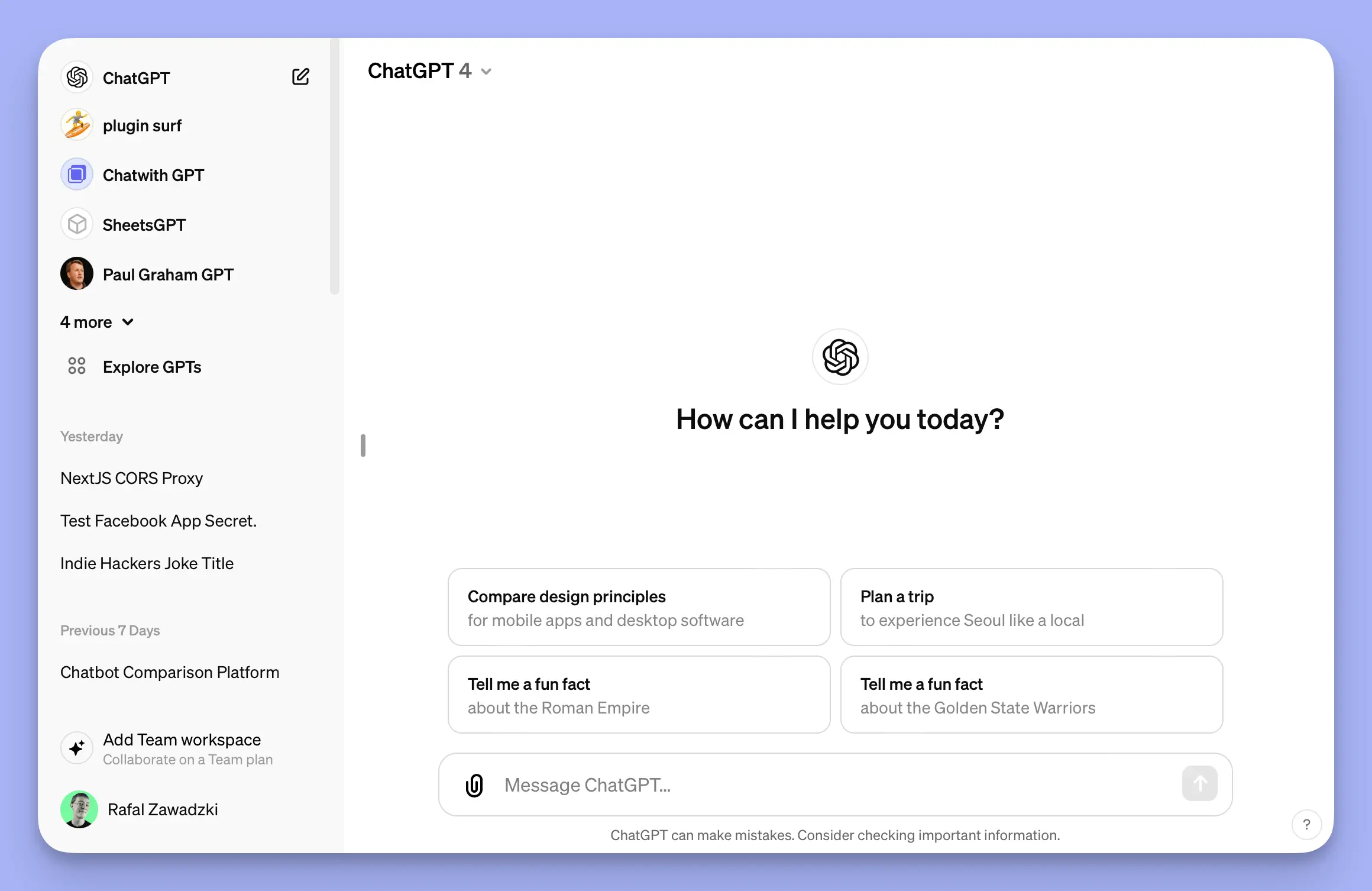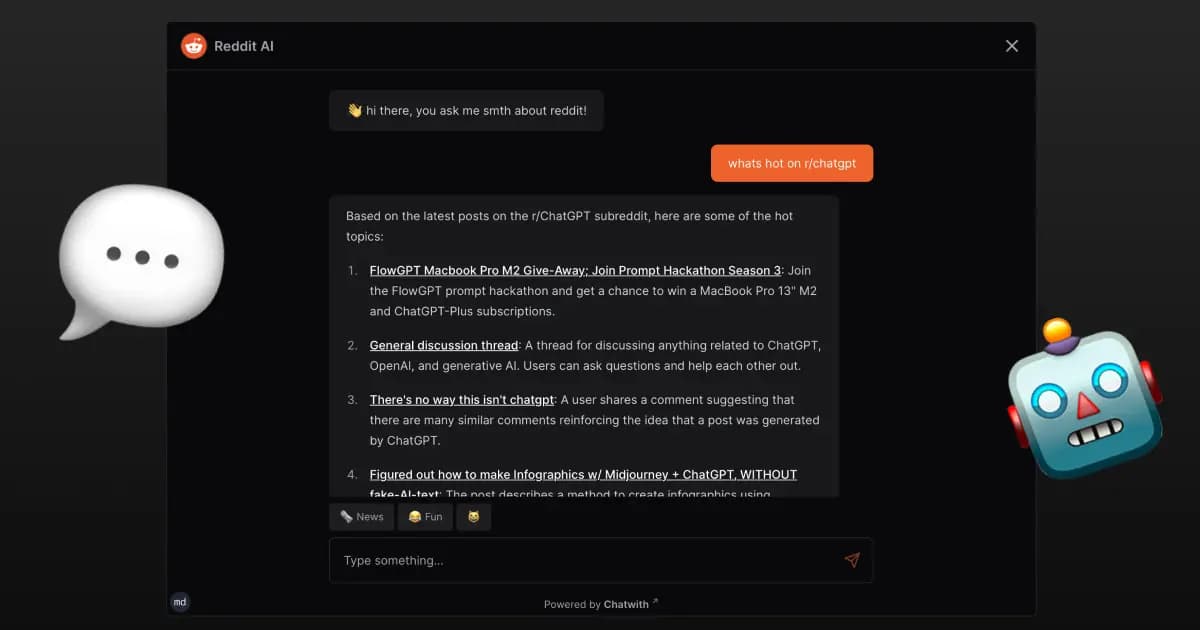
Founder of Chatwith
Practical ways to use ChatGPT in business (Chat GPT AI)
What is ChatGPT and how can a business benefit from using it?
ChatGPT is an AI-powered conversational tool developed by OpenAI that leverages generative AI to understand and respond to user queries. For a business of any size, ChatGPT and similar technologies can be a game-changer: saving time, helping understaffed teams, aiding creativity and problem solving.
In this article, I've outlined a few practical use-cases and examples of how I use ChatGPT in my business - and how you can, too!
The basics of ChatGPT
ChatGPT is an application developed by OpenAI that uses GPT (Generative Pre-Trained Transformer - what a mouthful!) - a large language model to generate human-like responses to text prompts. ChatGPT can be directly used through a simple chat conversation, but it can be also made into more advanced tools like specialized chatbots, assistants, custom GPTs and AI agents.
Because ChatGPT is just a chat, it is very easy to start with. Simply start typing and see what the AI has to say! The real fun begins when you realize its true potential and learn how to leverage it by asking the right questions - so called prompts.

Benefits of using ChatGPT in a business
ChatGPT can benefit your business in multiple ways. It can provide automated customer service through chatbots, generate content for marketing campaigns, analyse customer feedback, assist with data analysis and research, create reports and presentations... The list goes on. It can help teams both small and large, and if you're a freelancer or a small business owner, getting ChatGPT can feel like an extra team member has just joined your company!
Practical examples and use cases for using ChatGPT in a business
1. Training a custom ChatGPT chatbot to answer frequently asked questions
Another interesting use case for ChatGPT is training a custom chatbot to assist with customer support. You can start simply by copying long email and asking ChatGPT to write a response to it. Then, you can step it up a notch and create a custom GPT that already contains the basic context on your business, so you don't have to repeat yourself all the time!
Besides the basic features of ChatGPT, there is also a whole industry offering specialized tools that involve AI in all kinds of customer support tasks: from email automation, to CRM management and even trained AI chatbots (like Chatwith) that can take your customer support on autopilot.
By integrating AI into the customer service workflow you have the opportunity to automate common tasks, automatically provide instant responses to customer queries, and offer personalized assistance round the clock.
2. Writing code and developing software using chatbots
One of industries getting disrupted by AI the fastest is software development. Businesses can use ChatGPT for writing code, debugging and completing various related tasks like code reviews, documentation, or even brainstorming ideas for new features or products.
This can be particularly useful for small businesses with limited resources, as ChatGPT increases the developer productivity and helps ensure high-quality code outputs. It can act as a coding assistant and with innovative new tools like Cursor or Devin, even assume the role of a junior software developer!
3. Brainstorming and creative problem solving with Chat GPT
ChatGPT can serve as a valuable resource when it comes to brainstorming ideas and solving creative problems. Simply describe your challenges, projects or ideas to ChatGPT and let its generative capabilities spark your creativity. Whether you need help coming up with a new marketing strategy, designing a product, writing a script, or brainstorming ideas for a project, ChatGPT can assist you in generating creative solutions.
Here is a prompt I often use to summarize large amounts of user feedback (eg. from surveys or emails) and extract insights to help shape the product roadmap:
You are an experienced product manager. Summarize the user feedback below. Use markdown for formatting. Provide insights, tips and actionable next steps. If applicable, provide a prioritised roadmap. Assume the product is developed by a small team and is in a rapidly changing market. Here is the user feedback:
4. Using ChatGPT for generating marketing copy, social media posts and SEO
One practical way to use ChatGPT in your business is for generating marketing copy, social media posts, blog articles and other content. By feeding prompts (or questions) to ChatGPT, you can quickly generate engaging content that resonates with your target audience. While ChatGPT can be used to generate whole posts, it is also useful in creating outlines or improving existing articles.
Businesses can also leverage ChatGPT to experiment with different marketing strategies and refine their messaging based on the responses generated. It is also very effective in SEO! By providing ChatGPT with relevant keywords and topics, you can generate SEO-friendly content or even just brainstorm different titles for your next blog post.
5. Business data analysis and reporting
If you're looking to analyze customer data, generate reports, and extract insights from large datasets, ChatGPT can be a powerful tool. Make sure to get ChatGPT Plus: it gives you access to the powerful Code Interpreter tool that lets you upload files (eg. a CSV) and then employs AI to create and execute code that crunches the data contained in that CSV. That's it: without opening Excel, you can ask this advanced AI to calculate fields and even create charts and visualise the data contained in a spreadsheet.
Using ChatGPT for data analysis and reporting can help your business make informed decisions, identify opportunities for growth, and optimize your operations based on data-driven insights.
6. Proofreading, checking grammar and translation
ChatGPT can also be used for proofreading, checking grammar, and translation tasks in a business context. While there are many various tools helping with such tasks already, having all these features available in one place makes it even easier to use.
By inputting text passages or documents into ChatGPT, you can receive instant feedback on spelling, grammar, and sentence structure, helping to ensure that your content is error-free and well-written. You can also use ChatGPT to translate text between different languages, ask for synonyms or rewrite your text to be easier to understand. It's like a professional editor, but for free!
How to get started with using Chat GPT for your small business
Are you ready to take your small business to the next level in the digital age? From content creation to customer service, there are so many ways ChatGPT can help you save time and money - and even bring a little fun and fresh perspective. Don't miss out on the power of AI!
To get started, you can sign up for a free version of ChatGPT. Try asking it a few questions or some of the tips I shared with you above. If you work in a team, the next step could be sharing this article with them and evaluating how AI fits in your broader organisation. Who knows - this could be the first step towards a new, exciting future.
More from our blog
How to improve e-commerce customer support with a custom ChatGPT chatbot
Customize ChatGPT for e-commerce to offer 24/7 support, personalized interactions, and reduce costs, while improving the online shopping experience.
How to make a custom ChatGPT chatbot for the Reddit API with OpenAPI
Hands on tutorial for creating a ChatGPT chatbot that interacts with Reddit API using OpenAPI and NextJS to answer questions about subreddit posts

